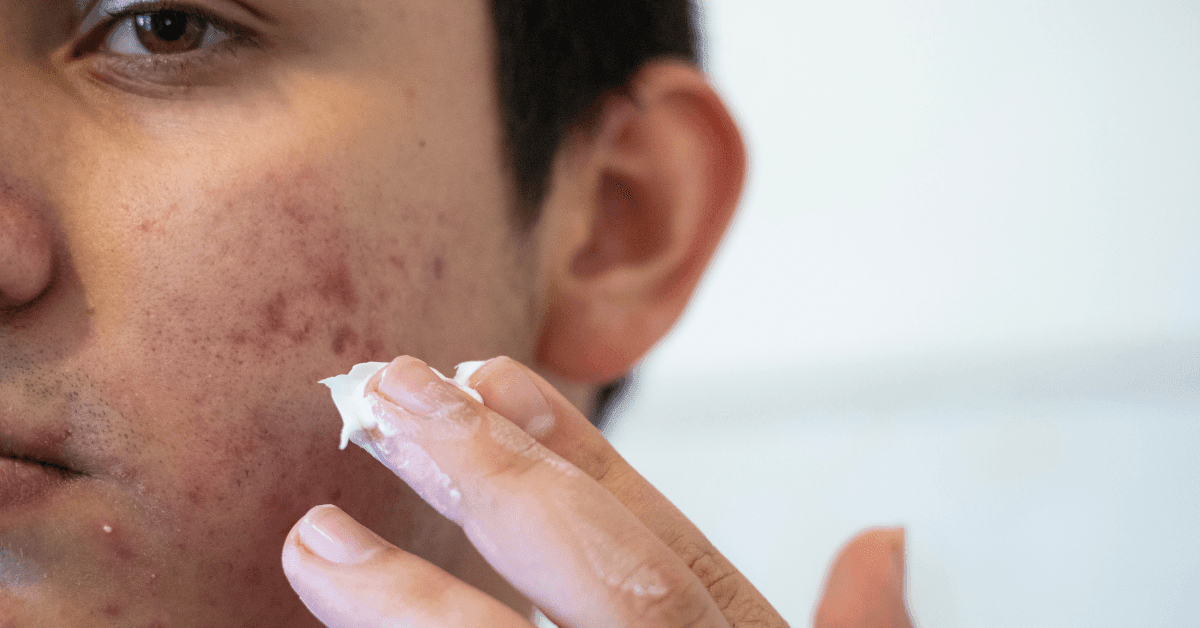
Tired of stubborn breakouts? We created this simple acne guide backed by dermatologists just for you. Let's cover the lifestyle fixes and product tips to help you clear acne fast.
Why Do Men Get Acne?
Acne isn’t a teen problem. 1 in 5 men struggle with breakouts well into adulthood. Here’s why:
- Hormones: Testosterone spikes oil (sebum) production, clogging pores.
- Shaving: Razors irritate skin, causing razor bumps and ingrown hairs.
- Sweat & Dirt: Gym sessions or outdoor work trap bacteria in pores.
- Stress & Diet: High sugar, dairy, and processed foods trigger inflammation.
Male Skin Fact: Men’s skin is thicker and oilier than women’s, so acne treatments need to be stronger yet non-drying.
The Best Men’s Skincare Routine for Acne
1. Cleanse Twice Daily
Do: Use a natural, gentle, sulfate-free cleanser to kill bacteria.
Don’t: Overwash (it strips moisture, worsening breakouts).
Example: Our Face Cleanser contains Sage Leaf, which helps kill bacteria.
2. Exfoliate (2-3x Weekly)
- Chemical exfoliants: Glycolic acid (for surface dead skin) or salicylic acid (for deep pores).
- Avoid: Scrubs with walnut shells or rough surfaces as they may cause micro-tears.
3. Treat Active Breakouts
- Benzoyl peroxide: Reduces swelling (use as a spot treatment).
- Niacinamide (5%+): Calms redness and regulates oil.
4. Moisturize (Yes, Even Oily Skin!)
Myth: "Moisturizer causes acne."
Truth: Skipping it makes skin overproduce oil.
Example: Our Face Cream which contains Hyaluronic Acid and Rowan Berry Extract.
5. Apply Sunscreen Daily
UV rays darken acne scars. Choose a matte, SPF 30+ sunscreen.
5 Acne Mistakes Most Men Make
- Using bar soap or 3-in-1 washes (too harsh; disrupts skin’s pH).
- Popping pimples (pushes bacteria deeper, causing scars).
- Skipping aftershave care (alcohol-based splashes dry out skin).
- Overusing “acne” products (leads to peeling and irritation).
- Neglecting pillowcases & phone screens (bacteria transfer!).
Male Skin Fact: 25% of adult men struggle with acne due to stress, hormones, or skincare neglect. It’s never "too late" to treat it.
Lifestyle Changes to Prevent Acne
Diet Adjustments
- Avoid: Dairy (linked to hormonal acne), sugar, and fried foods.
- Eat More: Zinc (pumpkin seeds), omega-3s (salmon), and greens.
Post-Workout Skincare
- Shower immediately after sweating to prevent clogged pores.
- Use body wash with salicylic acid for chest/back acne.
Stress & Sleep
High cortisol levels make your skin oilier. Aim for 7–8 hours of sleep and try relaxation practices like meditation.
Shaving Tips
- Use a sharp, single-blade razor.
- Apply a pre-shave oil to reduce friction.
- Finish with a soothing balm (look for aloe or witch hazel).
When to See a Dermatologist
Seek help if you have:
- Cystic acne (large, painful bumps under the skin).
- Scarring or hyperpigmentation.
- No improvement after 6–8 weeks of consistent care.
Prescription options: Retinoids (tretinoin), antibiotics, or hormonal treatments.
Final Thoughts
Acne isn’t unbeatable. Stick to a simple, consistent routine, avoid triggers, and give products 4-6 weeks to work. For stubborn cases, a dermatologist can help.
Ready to upgrade your routine? Explore our essential range of skincare products.
Citations
- American Academy of Dermatology (AAD). (2023). Adult Acne. https://www.aad.org
- NHS. (2024). Acne Treatments. https://www.nhs.uk
- Journal of Clinical and Aesthetic Dermatology (2022). Diet and Acne Review.










